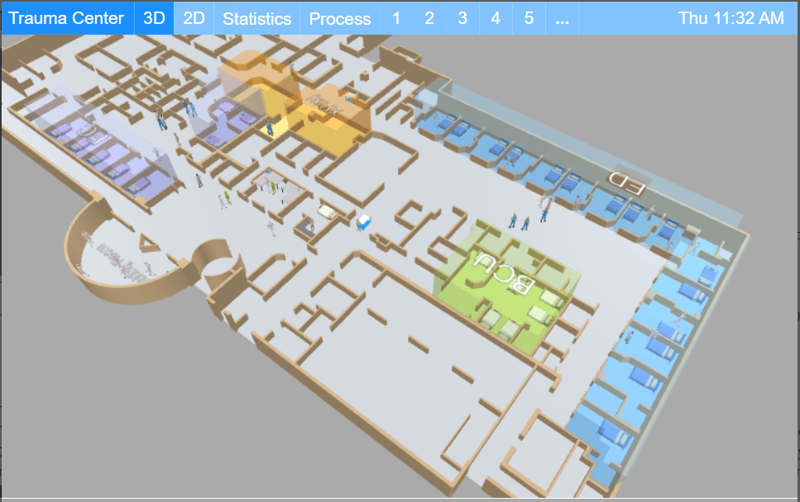Simulation for Healthcare Operations
We build Advanced Analytics technology to improve throughput, reduce cost, and maximize efficiency of your operations.
This is a fully interactive simulation model. Press play, pinch to zoom in and out, and click 'Statistics' to change input parameters like the number of staff, type of staff, and machines. If you'd like to schedule time to learn more, please submit your name and email in the form below.

Healthcare Operations Are Complex
Healthcare operations leaders have a tough job. They're often tasked with managing increasing patient volumes with limited resources, balancing budgetary constraints with the need for quality care, and improving staff productivity among labor shortages. Whether they're in an Emergency Department, Surgical Center, or material handling for a health system - they're managing a complex system with variability and resource constraints changing over time. Making sense of that complexity is impossible with traditional tools like spreadsheets.
By harnessing the power of simulation, optimization, and Digital Twin, you can provide better care to patients, optimize resource allocation, and reduce costs.
Patient Flow Optimization
Identify bottlenecks and inefficiencies in patient flow within hospitals or clinics, leading to improved resource utilization, reduced patient waiting times, and reduced length of stay.
Emergency Department Management
Simulate patient arrivals, treatment times, and staffing levels in emergency departments to optimize patient care and minimize waiting times.
Operating Room Schedules
Compare scenarios and constraints to optimize operating room schedules, reduce delays and maximize resource utilization.
Staffing and Resource Planning
Determine the optimal staffing levels, mix of skills, and shift patterns for healthcare professionals, ensuring that patient needs are met while minimizing costs.
CapEx Investments
Use simulation and optimization tools to assess the impact of different capital expenditure projects, helping prioritize investments that yield the highest return or improve operational efficiency.
Outpatient Clinic Management
Model the flow of patients in outpatient clinics and to evaluate the impact of changes in scheduling policies, appointment types, and resource allocation.
Bed Management & Capacity Planning
Supply Chain and Material Handling
Epidemic Outbreak Spread and Response Strategy
Health Policy Evaluation
Telemedicine and Remote Monitoring
Healthcare Route Optimization
MohOpt automates the process of selecting who to serve, where to stop, and how to get there so you reduce transportation cost and improve operational efficiency.

Improve Patient Care and Staff Satisfaction
Discover the antidote to your evolving healthcare operations challenges with advanced analytics. Together, we'll help you improve throughput, reduce Length of Stay (LOS) and patient satisfaction while driving down costs so you can deliver better care and a better work environment for your valued team.
Explore How Simulation Modeling Helps
Optimize patient flow. Patient flow optimization is the process of improving the movement of patients through a healthcare facility, from admission to discharge, in the most efficient and effective manner possible. By simulating different scenarios and configurations, healthcare managers will understand how various factors, such as patient arrival patterns, treatment durations, and resource availability, affect patient flow. The benefits of patient flow optimization include identifying points of congestion or delays, testing interventions like the number of beds and nurses or adjusting appointment schedules, and balancing resources to find the most efficient and effective way to allocate staff, equipment, and space.
Staffing and workforce planning. Staffing and workforce planning in healthcare involves determining the optimal number of healthcare professionals with the right mix of skills and competencies to meet the needs of the patient population while minimizing costs and ensuring high-quality care. Simulation enables the analysis of complex staffing scenarios and provides insights into the effects of different staffing configurations on system performance. Simulation for staffing and workforce planning typically includes workforce demand (simulating patient arrivals, service demands, seasonality) and workforce supply (working hours, shift patterns, skill mix, and productivity levels). With a simulation model operations leaders can test various staffing scenarios by adjusting variables such as staff, skill, and shift patterns to predict the impact of these changes on KPIs such as patient waiting times, service quality, and resource utilization. Simulation in workforce planning ultimately leads to more efficient and effective healthcare delivery.
Optimize Operating Room Schedules. Operating room (OR) scheduling is a complex and critical aspect of hospital management, as it involves coordinating the availability of surgeons, anesthesiologists, nurses, and other support staff, ensuring that the necessary equipment and resources are in place for each procedure, and the flow of material. Using Advanced Analytics like simulation enables healthcare managers to balance the competing objectives of maximizing resource utilization, minimizing patient waiting times, and ensuring high-quality care. The model can capture the various stages of the surgical process along with resource availability and variability in the system (uncertainty) like duration of surgery and patient arrivals. This enables healthcare managers to analyze the flow of patients through the operating rooms and identify potential bottlenecks or inefficiencies. Optimized OR schedules improves patient care, increases staff satisfaction, and enhances overall hospital efficiency.
Maximize Your Potential When You ...
Turn Insights into Action
Our advanced modeling tools provide the relevant information you need to make more informed decisions, faster.
Know What Will Work & How
Boost Efficiency & Reduce Risk
Many moving parts impact your operations. See where you’re wasting money, time, and energy, and understand how to make improvements.





